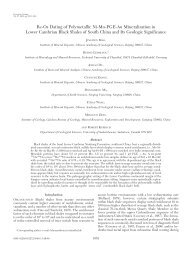MACROCRYSTALS OF Pt–Fe ALLOY FROM THE ... - RRuff
MACROCRYSTALS OF Pt–Fe ALLOY FROM THE ... - RRuff
MACROCRYSTALS OF Pt–Fe ALLOY FROM THE ... - RRuff
Create successful ePaper yourself
Turn your PDF publications into a flip-book with our unique Google optimized e-Paper software.
614 <strong>THE</strong> CANADIAN MINERALOGIST<br />
FIG. 10.<br />
Inclusions of mertieite-II in matrix of <strong>Pt–Fe</strong> alloy. Sample III (oil immersion).<br />
FIG. 11. Inclusions of fluorapatite in <strong>Pt–Fe</strong> alloy. Sample IV<br />
(oil immersion).<br />
Anomal’niy Creek and its secondary dispersion pattern<br />
(Nekrasov et al. 1999). The inclusion assemblage of the<br />
coarse <strong>Pt–Fe</strong> alloy crystals also suggests a petrogenetic<br />
association with the late apatite – magnetite – phlogopite<br />
clinopyroxenite bodies, but not with the dunitedominant<br />
main intrusion. The latter is in agreement with<br />
the suggestion by Malitch & Thalhammer (2002) that<br />
the unit-cell type of Pt 3 Fe minerals depends on the host<br />
rock and that ferroan platinum is characteristic of<br />
clinopyroxenite.<br />
The large size of the crystals could be related to crystal<br />
growth in a pegmatitic environment with a protracted<br />
magmatic evolution, i.e., from residual liquids that eventually<br />
reached fluid saturation. The latter event possibly<br />
promoted the formation of miaroles or interstitial space<br />
in which coarse-grained idiomorphic PGM could form<br />
at a relatively low temperature. A similar setting applies<br />
to the Tweefontein area in South Africa, where large<br />
euhedral crystals of sperrylite up to 1.85 cm across occur<br />
in granite pegmatite and on shear zones in ironstone<br />
country-rocks of the Platreef (Wagner 1929). The coarse<br />
sperrylite crystals were interpreted as being of late-stage<br />
magmatic–hydrothermal origin (Cawthorn et al. 1998).<br />
The cause of the extreme fractionation of platinum<br />
from the other PGE in the coarse <strong>Pt–Fe</strong> alloy crystals is<br />
a matter of speculation. The solubilities of Pt and Os, Ir<br />
or Rh in a sulfur-free silicate melt are not dramatically<br />
different (Borisov & Palme 1997, Borisov & Walker<br />
2000, Ertel et al. 1999). However, experimental data on<br />
the partition coefficient between metal and silicate melt<br />
indicate that D (Pt) is 3–4 orders of magnitude higher<br />
than D (Os) at 1300–1400°C (Borisov & Walker 2000).<br />
This effect may be even larger at lower temperature and<br />
could possibly produce the huge separation of platinum<br />
from osmium (and the geochemically similar Ir, Ru,<br />
Rh). The low Pd content could be explained by the much<br />
higher solubility of Pd, compared to all other PGE, in<br />
silicate melt, similar to the solubility of Au (Borisov &<br />
Palme 1996). The Pd–Au component and base metals










